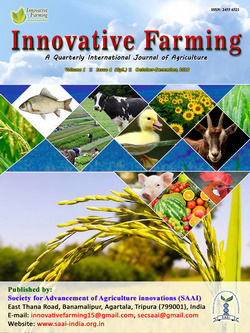
Diversity of Mealybug Parasitoids (Chalcidoidea: Encyrtidae) from Tamil Nadu
Ayyamperumal, M.*
Department of Entomology, Faculty of Agriculture, Annamalai University, Annamalainagar, Tamil Nadu- 608 002, INDIA
S. Ajaykarthick
Department of Entomology, Faculty of Agriculture, Annamalai University, Annamalainagar, Tamil Nadu- 608 002, INDIA
S. Manickavasagam
Department of Entomology, Faculty of Agriculture, Annamalai University, Annamalainagar, Tamil Nadu- 608 002, INDIA
DOI: NIL
Keywords: Encyrtidae, Tritrophic relationship, Entomophagus insects, Parasitoid
Abstract
Sucking pest is one of the major threats in Agricultural and Horticultural ecosystems and mealybug plays a crucial role in higher damage. Parasitic Hymenoptera are a viable alternative for chemical pest control especially for this group of insects. Chalcidoidea is one of the entomophagus insects utilized for mealybug management and within Chalcidoidea, members belonging to Encyrtidae play a major role in bringing down their population in nature. In the present study, surveys were conducted to collect different mealybug hosts along with their host plants from various ecosystems. The collected mealybugs were reared under laboratory conditions and observed for possible parasitoid emergence. The following are the major mealybugs collected and parasitoids reared from them. Cotton mealybug, Phenacoccus solenopsis Tinsley (Aenasius arizonensis (Girault), Prochiloneurus aegyptiacus (Mercet), Gentakola trifasciata (Saraswat), Promuscidea unfasciativentris Girault.); Papaya mealybug, Paracoccus marginatus Williams and Granara de Willink, Pseudleptomastix mexicana Noyes and Schauff, Acerophagus papayae Noyes and Schauff; Eggplant mealybug, Coccidohystrix insolita (Green) Leptomastix nigrocincta Risbec, L. nigrocoxalis Compere, Prochiloneurus pulchellus Silvestri, P. aegyptiacus (Mercet), Chartocerus sp. Promuscidea unfasciativentris Girault; Citrus mealybug, Planococcus citri (Rissco) Leptomastix nigrocoxalis Compere; Striped mealybug, Ferrisia virgata (Cockerell) Aenasius advena (Compere), A.indicus (Narayanan and Subba Rao), Anagyrus indicus (Subba Rao), Blepyrus insularis (Cameron); Root mealybug, Formicoccus polysperes Williams: Anagyrus kamali. Blepyrus insularis (Cameron). In addition, the parasitoids were also recognized at trophic level as to primary or secondary parasitoids apart from recording the entomophagous insects of parasitoids, if any. The host plants, host insects and parasitoids attacking the host insects and entomophages attacking the primary parasitoids are presented in a flowchart depicting the tritrophic relationship for easy understanding by biocontrol workers.
Downloads
not found
Reference
Anonymous, 1995. Technology for production of natural enemies, published by the Project Directorate of Biological Control, Bangalore, pp 220.
Franco, J.C., E. Borges da Silva and J. Passos de CarvalhoJ. 2000. Cochonilhas-algodao (Hemiptera, Pseudococcidae) associadas aos citrinos em Portugal. ISA Press, Lisboa.
Hayat, M. 2006. Indian Encyrtidae (Hymenoptera: Chalcidoidea). Published by M. Hayat, Department of Zoology, Aligarh Muslim University, India. Viii+496.
Keraba, S.K. 2011. Mealybugs infesting some major fruit crops of the konkan region of Maharashtra (India). Ph.D. Thesis, Dr. Balasaheb Sawant Konkan Krishi Vidyapeeth, Dapoli, pp 13.
Khaskheldi, M.A. 2006. Cotton mealybug – Emerging threat to cotton, electronic Database accessible at http://www.pakissan.Com/English/advisory/mealy.bug.an.emerging.threat. to.cotton.crop.shtml. Captured on July 2010.
Lower, H.F. 1968. Hard to kill pests of fruit crops. Journal of Agriculture, 72: 75-77.
Manickavasagam, S., J. Poorani, S. Vennila and A. Rameshkumar. 2013. Present Status of the natural enemies of Phenococcus solenopsis Tinsley (Hemiptera: Sternorrhyncha: Coccoidea: Pseudococcidae), an invasive pest in India, pp 37. In: 3rd International Entomophagous Insects Conference, Canada.
Manjunath, T.M. 1985. India- Maconellicoccus hirsutus on grapevine. FAO-Plant- Prot. Bull., 33(2): 74.
Mani, M., A. Krishnamoorthy, and C. Shivaraju. 2011. Biological suppression of major mealybug species on horticultural crops in India. Journal of Horticultural Science, 6(2): 85-100.
McKenzie, H.L. 1967. Mealybugs of California: With taxonomy, biology and control of North American species. University of California Press, Berkeley and Los Angeles.
Moore, D. 1988. Agents used for biological control of mealybugs (Pseudococcidae). Biocontrol News and Information, 9: 209-225.
Nalini, T. and S. Manickavasagam. 2011. Records of Encyrtidae (Hymenoptera: Chalcidoidea) parasitoids on mealybugs (Hemiptera: Pseudococcidae) from Tamil Nadu, India. Check List, 4: 510-515.
Noyes, J.S. 1982. Collecting and preserving chalcid wasps (Hymenoptera: Chalcidoidea). Journal of Natural History, 16: 315‒334.
Noyes, J.S. and M. Hayat. 1994. Oriental Mealybug Parasitoids of the Anagyrini (Hymenoptera: Encyrtidae). Oxon: CAB International, pp 554.
Ram, P and R.K. Saini. 2010. Biological control of solenopsis mealybug, Phenacoccus solenopsis Tinsley on Cotton: a typical example of fortuitous biological control. Journal of Biological Control, 24(2): 104-109.
Suresh, S., R. Jothimani, P. Sivasubramanian, P. Karuppusamy, R. Samiyappan and E.I. Jonathan. 2010. Invasive mealy bugs of Tamil Nadu and their management. Karnataka Journal of Agricultural sciences, 23(1): 6-9.
Tanwar, R.K., P. Jeyakuma, A. Singh, A.A. Jafri and O.M. Bambawale. 2011. Survey for cotton mealybug, Phenacoccus solenopsis (Tinsley) and its natural enemies. Journal of Environmental Biology, 32: 381-384.
